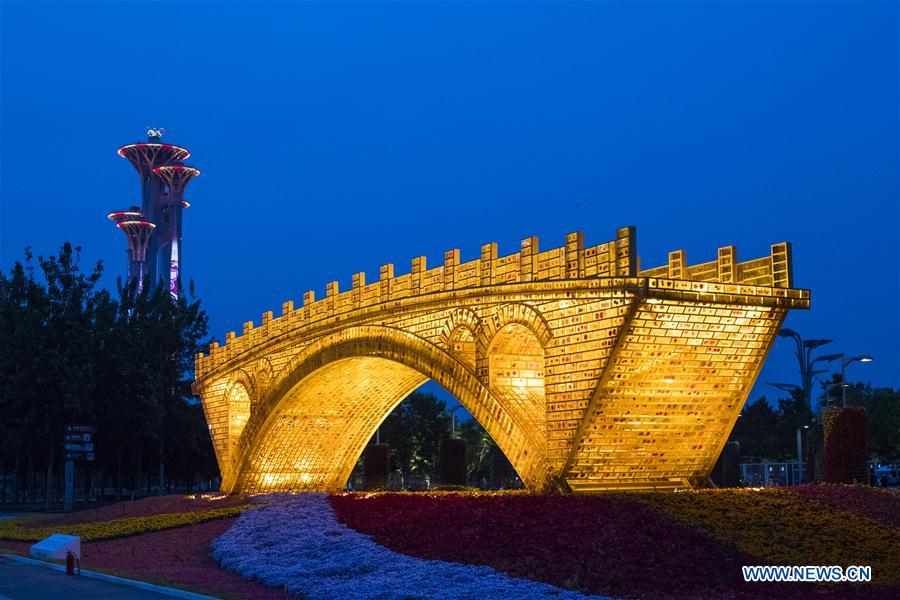


Photo taken on May 9, 2017 shows the "Golden Bridge on Silk Road" structure in Beijing Olympic Park in Beijing, capital of China.
The U.S. Pentagon has endorsed a plan, known as the Asia-Pacific Stability Initiative (APSI), to invest nearly $8 billion to bulk up the U.S. presence in the Asia-Pacific region over the next five years by upgrading military infrastructure, conducting additional exercises, and deploying more forces and ships, The Wall Street Journal reported on May 7. That comes in addition to the $54 billion in new military spending requested for next year’s federal budget.
The effort to bulk up the U.S. presence in the Asia-Pacific region is seen by backers of the plan as a way to signal U.S. commitment to the region. It was initially put forward by U.S. Senator John McCain, and the general concept of the plan is supported by U.S. Defense Secretary Jim Mattis and head of the U.S. Pacific Command, Admiral Harry Harris.
Several U.S. senators have expressed their support for the creation of the APSI: “Like you, we remain concerned with the eroding military balance,” the senators said in a letter to Secretary Mattis penned in February. They called on Secretary Mattis to maintain U.S. leadership in the Asia-Pacific and said that the initiative will show both allies and adversaries that the U.S. remains committed to the region.
But rather than boost confidence in U.S. commitment, the initiative shows just how out-of-step the U.S. has become with the changing world order. Building an iron wall of military power to maintain dominance might reassure U.S. allies, such as Japan, but the effort goes squarely against the region’s efforts to promote common development and win-win cooperation. In addition, Asia-Pacific-focused initiatives such as the APSI are likely to be seen as moves to contain China, increasing friction between the two major countries.
Rather than seek dominance in the region, the U.S. should follow in China’s footsteps and seek integration. With the Belt and Road Initiative, China is playing a constructive role in the region, focusing tremendous efforts and resources on promoting an open and inclusive plan that will benefit not only China, but all countries of the world, regardless of their size, strength, or regime type. This stands in stark contrast to the Pentagon-backed plan.
The U.S. has a lot to gain by participating in the Belt and Road, an initiative that Chinese Foreign Minister Wang Yi describes as “the most important public good China has given to the world” to date. The U.S. made a strategic mistake by shunning the Asian Infrastructure Investment Bank. Why the U.S. would compound that mistake and add insult to injury by shunning efforts for more open and inclusive development, frankly, makes no sense. That is why it is important, as Beijing prepares to host the Belt and Road Forum for International Cooperation, that the U.S. embrace China’s progress in regional integration and seize the opportunity to join the “symphony” of the Belt and Road Initiative, a plan that encourages all countries of the world to play a constructive role in the region’s future.

 Award-winning photos show poverty reduction achievements in NE China's Jilin province
Award-winning photos show poverty reduction achievements in NE China's Jilin province People dance to greet advent of New Year in Ameiqituo Town, Guizhou
People dance to greet advent of New Year in Ameiqituo Town, Guizhou Fire brigade in Shanghai holds group wedding
Fire brigade in Shanghai holds group wedding Tourists enjoy ice sculptures in Datan Town, north China
Tourists enjoy ice sculptures in Datan Town, north China Sunset scenery of Dayan Pagoda in Xi'an
Sunset scenery of Dayan Pagoda in Xi'an Tourists have fun at scenic spot in Nanlong Town, NW China
Tourists have fun at scenic spot in Nanlong Town, NW China Harbin attracts tourists by making best use of ice in winter
Harbin attracts tourists by making best use of ice in winter In pics: FIS Alpine Ski Women's World Cup Slalom
In pics: FIS Alpine Ski Women's World Cup Slalom Black-necked cranes rest at reservoir in Lhunzhub County, Lhasa
Black-necked cranes rest at reservoir in Lhunzhub County, Lhasa China's FAST telescope will be available to foreign scientists in April
China's FAST telescope will be available to foreign scientists in April